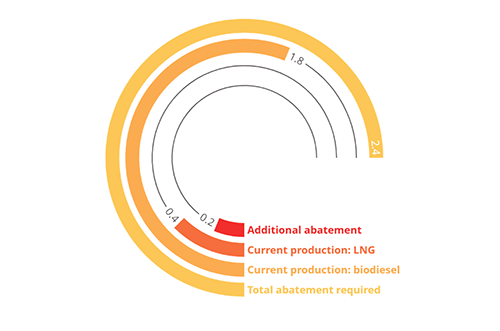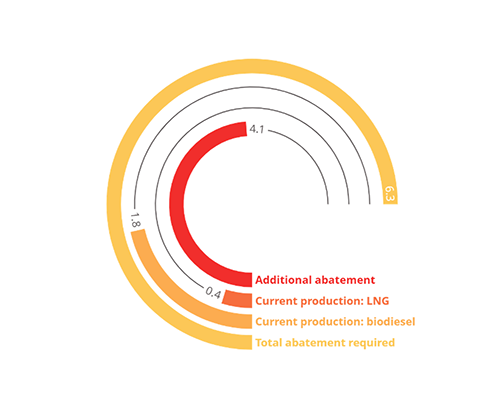The maritime sector, although in some ways a conservative and slow-moving business in the case of innovation, has quietly set itself as much as be one of the crucial progressive industries when it comes to sustainability and decarbonization. The Worldwide Maritime Group has set bold decarbonization targets and rising worldwide and industrywide rules and requirements are spurring world delivery actors to cut back emissions and undertake extra sustainable options.
One of many main hurdles standing in the way in which of deep decarbonization of the maritime sector is the problem of the event, deployment, and uptake of extra sustainable fuels. Whereas some emissions reductions may be gained by a spread of low-emission vessel innovation options, equivalent to route optimization software program, wind-powered propulsion, or current bio-based fuels on the water right now, restricted scalability and an incapacity to realize close to 100% emissions discount impacts the long-term viability of those options. It’s turning into more and more clear that long-term decarbonization of the maritime area would require the widespread uptake of e-fuels.
Biofuels and LNG (liquified pure fuel) have been two of the preliminary options however have had feedstock bottlenecks and comparatively low emissions reductions. A current report by the Maersk-McKinney Moller Middle for Zero Carbon Transport discovered that the EU fleet is on monitor to satisfy 90% of required emissions discount by means of 2029 with biodiesel and LNG alone. Nevertheless, as emissions discount necessities change into more and more stringent, projected use of biofuels and LNG will solely meet about 30% of necessities for 2030-2034.
Gas Use to Meet 2025-2029 2% Emissions Discount Goal (in Mil tonnes CO2eq)

Supply: Information from Maersk-McKinney Moller Middle for Zero Carbon Transport
Gas Use to Meet 2030-2034 6% Emissions Discount Goal (in Mil tonnes CO2eq)

Supply: Information from Maersk-McKinney Moller Middle for Zero Carbon Transport
E-Fuels Wanted to Meet Future Abatement Hole
E-fuels, or artificial hydrogen fuels (90%+ emissions reductions in comparison with typical bunker gas), are seen by many as the one viable pathway for deep maritime decarbonization. Important challenges stay that hinder the widespread market uptake of e-fuels, together with obstacles from excessive manufacturing prices, restricted renewable power capability, technical roadblocks, and storage and dealing with challenges.
Moreover, uncertainty round which e-fuels will probably be best and market-ready gradual decision-making from fleet house owners and operators, diminishing market demand and funding within the close to time period. Numerous business actors, nonetheless, are taking over the problem of addressing these key obstacles to the event and deployment of e-fuels within the maritime sector, whether or not that be offering infrastructure funding to scale up e-fuel manufacturing tasks (e.g., Breakthrough Power) or piloting e-fuel bunkering options and requirements (e.g., MPA Singapore).
Market Mover Highlight: Zero Emission Maritime Consumers Alliance (ZEMBA)
Discussions on “bridging the hole” when it comes to scaling cleantech innovation are inclined to deal with the funding hole. Nevertheless, the market demand hole for sustainable innovation is an equally daunting problem. ZEMBA is working to bridge this traditional “valley of loss of life” that many new markets face between analysis and growth and the numerous scaling then required to facilitate sturdy industrial deployment.
ZEMBA describes the challenges dealing with the maritime sector as a basic chicken-and-egg downside in creating and scaling a marketplace for new clear energy-derived fuels and applied sciences. Demand is stymied by excessive preliminary predicted prices of delivery companies powered by these options. A ensuing lack of ample dedicated demand from company freight consumers (cargo house owners) erodes investor confidence, in addition to urge for food for threat amongst maritime stakeholders who might want to order new kinds of vessels, construct new gas manufacturing services, and create supportive coverage at world, regional, and nationwide ranges.
What are the fundamentals of ZEMBA’s operations? How does the tender course of work?
ZEMBA members characterize the top buyer within the maritime worth chain, and inside this sector, they’ve traditionally relied on the carriers they use to supply them with greener options. Nevertheless, no freight purchaser is sufficiently big on their very own to incentivize the market to transition to new scalable options like e-fuels.
Because of this ZEMBA works to pool freight purchaser demand, bringing collectively the shopping for energy of over 40 firms world wide. By means of ZEMBA’s tenders, prepared consumers (i.e., aggregated demand) are introduced collectively to sign their demand early, giving the market time and confidence to handle these market growth challenges, put together the required infrastructure, and ship over longer contracts.
ZEMBA´s first tender was launched in 2023, for 3.5 billion TEU-nautical miles of zero emission delivery companies over a three-year interval. This inaugural tender marked the first-ever collective multi-year offtake dedication for near-zero greenhouse fuel (GHG) delivery. When accomplished, 17 members signed bilateral agreements with winner Hapag-Lloyd and can obtain the emissions discount related to the ZEMBA tender in 2025 and 2026.
NOTE: ZEMBA organizers remark that they have been considerably stunned that they obtained no bids for e-fuel powered delivery— regardless of quite a few bulletins on the time about new e-fuel manufacturing tasks, e-fuel-capable vessels on order, and ZEMBA setting a 90% lifecycle emissions discount goal for bids.
In response to the dearth of marketplace for the e-fuels that will probably be essential to assembly future emissions abatement, ZEMBA has just lately launched its second tender, searching for bids from the containership phase particularly for e-fuel-powered delivery. On the finish of the tender course of, ZEMBA members will contract with the profitable service for simply the premium related to deploying the e-fuel service in comparison with a fossil gas service. In return, ZEMBA members obtain in-sector, in-value chain emissions discount credit. ZEMBA goals to announce the profitable conclusion of this e-fuel-focused tender by the top of 2025.
The uncertainty of which e-fuels will probably be best and market-ready is a divisive matter in the mean time, significantly surrounding methanol and ammonia. What has ZEMBA noticed relating to the demand and market-readiness for these two fuels?
ZEMBA stays open to any qualifying e-fuel-powered bid; you possibly can see our RFP 2 ZEMBA Eligible Gas Requirement doc to study extra about how we outline that in technical phrases. To reply your query, our RFI outcomes demonstrated that for containership companies launching in 2027, e-methanol-powered container delivery companies characterize the most probably bid pathways due to robust alignment between e-methanol manufacturing and methanol-capable ships. E-ammonia gas manufacturing was projected to have a equally robust development trajectory as e-methanol within the years forward, nonetheless the primary potential e-ammonia-capable containerships are rolling out extra slowly than many had hoped. Till there are containerships prepared to make use of that gas, we may even see the preliminary progress on ammonia in different segments of delivery like bulkers and tankers that transport commodities moderately than client merchandise.
How would you reply to VC/CVC buyers that suppose there’s little to no alternative for enterprise funding within the maritime decarbonization area? Do you agree? Are the important thing alternatives primarily infrastructure-level investments?
There are completely alternatives to put money into new firms designing new improvements. Maritime delivery is a large business that’s the spine of world commerce. Quite a lot of the funding wanted is in large infrastructure tasks, however this maritime clear power transition may even require new software program, new tools for vessels and port operations of assorted sizes, new information administration programs, and many others.
A mixture of public coverage and voluntary company motion by means of efforts like ZEMBA will assist creation of solely new markets for low-emission options. Like many sectors, is it a problem to know what clients will need sooner or later, in fact, however we propose VC buyers check out the standards ZEMBA places out for our tenders. We’re constructing this future market proper now, providing clear specs for the sort of options that we all know delivery’s company clients are searching for within the years forward. They’re greater than welcome to look to us as they search to learn the tea leaves.
For a tangible method to become involved within the progressive elements of the maritime sector, ZEMBA and Lloyd’s Register Maritime Decarbonisation Hub will probably be internet hosting a Maritime Innovation Commerce Honest this spring, a webinar highlighting innovators working to create a scalable, sustainable, and dependable maritime sector of the long run which are outdoors ZEMBA’s present tender.
Quotes attributed to CEO Ingrid Irigoyen and ZEMBA.